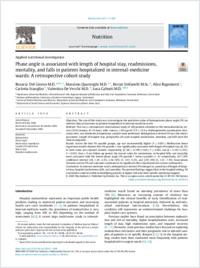Phase angle is associated with length of hospital stay, readmissions, mortality, and falls in patients hospitalized in internal-medicine wards : a retrospective cohort study
- Del Giorno, Rosaria Department of Internal Medicine, Clinical Research Unit, Regional Hospital of Bellinzona and Valli, Ente Ospedaliero Cantonale, Bellinzona, Switzerland - Institute for Research in Biomedicine (IRB), Faculty of Biomedical Sciences, Università della Svizzera italiana, Switzerland
- Quarenghi, Massimo Section of Clinical Nutrition and Dietetics, Department of Internal Medicine, Ente Ospedaliero Cantonale, Bellinzona, Switzerland
- Stefanelli, Kevyn Department of Social Sciences and Economics, Sapienza University of Rome, Italy
- Rigamonti, Alice Section of Clinical Nutrition and Dietetics, Department of Internal Medicine, Ente Ospedaliero Cantonale, Bellinzona, Switzerland
- Stanglini, Carlotta Section of Clinical Nutrition and Dietetics, Department of Internal Medicine, Ente Ospedaliero Cantonale, Bellinzona, Switzerland
- De Vecchi, Valentina Department of Internal Medicine, Clinical Research Unit, Regional Hospital of Bellinzona and Valli, Ente Ospedaliero Cantonale, Bellinzona, Switzerland
- Gabutti, Luca Department of Internal Medicine, Clinical Research Unit, Regional Hospital of Bellinzona and Valli, Ente Ospedaliero Cantonale, Bellinzona, Switzerland - Institute for Research in Biomedicine (IRB), Faculty of Biomedical Sciences, Università della Svizzera italiana, Switzerland
-
26.11.2020
Published in:
- Nutrition. - 2021, vol. 85, no. May, p. 7 p
Malnutrition
Phase angle
Bioelectrical impedance
Length of hospital stay
Risk of falls
Hospital readmissions
English
The aim of this study was to investigate the predictive value of bioimpedance phase angle (PA) on selected clinical outcomes in patients hospitalized in internal-medicine wards. This was a retrospective observational study of 168 patients admitted to the internalmedicine service (52.9% women, 47.1% men), with a mean (± SD) age of 73.9 ± 15.9 y. Anthropometric examination, laboratory tests, and bioelectrical impedance analysis were performed. Bioimpedance-derived PA was the study's parameter. Length of hospital stay, prospective all-cause hospital readmission, mortality, and falls were the clinical endpoints. Across the four PA quartile groups, age was incrementally higher (P ≤ 0.001). Multivariate linear regression models showed that PA quartile 1 was significantly associated with length of hospital stay (β, SE) in both crude and adjusted models —respectively, β (SE) = 6.199 (1.625), P ≤ 0.001, and β = 2.193 (1.355), P = 0.033. Over a 9-mo follow-up period, the hazard ratios for readmission, in-hospital falls, and mortality were associated with the lowest phase angle (PA quartile 1 versus quartiles 2–4)—respectively, 2.07 (95% confidence interval [CI], 1.28–3.35), 2.36 (95% CI, 1.05–5.33), and 2.85 (95% CI, 1.01–7.39). Associations between narrow PA and outcomes continued to be significant after adjustments for various confounders. In internal- medicine wards, bioimpedance-derived PA emerged as a predictor of length of hospital stay, hospital readmission, falls, and mortality. The present findings suggest that in the hospital setting, PA assessment could be useful in identifying patients at higher risk who need specific nutritional support.
- Language
-
- English
- Classification
- Pathology, clinical medicine
- License
- Open access status
- hybrid
- Identifiers
-
- RERO DOC 333385
- DOI 10.1016/j.nut.2020.111068
- ARK ark:/12658/srd1319264
- Persistent URL
- https://n2t.net/ark:/12658/srd1319264
Statistics
Document views: 229
File downloads:
- Fulltext: 250
